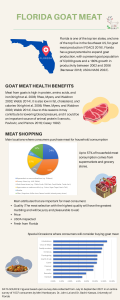This year, Meat Week began on January 29 and runs until February 5. To celebrate, we are highlighting some recent research from the UF/IFAS Food and Resource Economics Department focused on understanding consumer perception of goat meat as a specialty meat product.
According to a report from the United Nations’ Organisation for Economic Co-operation and Development (OECD) and the Food and Agriculture Organization (FAO)., growth in global consumption of meat proteins over the next decade is projected to increase by 14% by 2030. While this number accounts for other household protein choices of chicken, beef, pork and sheep, goat is another growing market to be explored and capitalized on by producers.
As a protein, goat meat offers many unique health benefits that set the product apart from other proteins. Florida in particular is one of the leading producers of goat meat domestically, ranked tenth in the country and fifth in the southeast United States, and so FRE graduate student Meri Hambaryan along with FRE faculty members Dr. John Lai and Dr. Bachir Kassas conducted survey research in order to better understand the current perceptions of goat meat held by Floridians.
“While demand for goat meat is increasing, people are still unaware of the health and environmental benefits of goat meat,” Hambaryan said. “The purpose of the study is to understand consumer decisions related to purchasing meat products, particularly goat meat. This knowledge will inform effective marketing tools for promoting the emerging goat meat industry in Florida.”
From July to September 2021, an online survey of 1037 consumers was completed, which included Florida adults 18 years of age and older who consume meat products and are the primary shoppers in their households (i.e., responsible for at least 50% of grocery shopping decisions). A choice experiment was included in the survey to understand consumer preferences for the following attributes: price (US dollar per pound), freshly produced in Florida, quality (in terms of marbling amount in meat), organic certification, and USDA inspection. Furthermore, the study collected socio-demographic data, as well as information regarding food-related lifestyles.
As seen in the following infographic designed by Hambaryan et al., the purchase of goat meat is most commonly associated with celebrations, and special occasions or holidays such as Cinco de Mayo, family reunions, or Christmas.
With their work on this subject, Hambaryan said that they aim to increase understanding of consumer preferences for goat meat, identify the role of information treatments, highlighting health and environmental benefits, on consumer preferences towards this meat option, and synthesize the results to provide policy recommendations for goat meat processors and the industry overall.
“The study’s findings should be of interest to farmers, goat meat producers, and decision-makers,” Hambaryan said. “We expect that this information will assist them in better understanding the market structure, as well as preference heterogeneity for goat meat, allowing them to better respond to the dynamic socio-economic environment in this emerging industry.”
Hambaryan said they have also started additional research into other aspects of understanding the effectiveness of goat meat marketing.
“Currently, we are working on a new project which will identify the role of pictorials and recipes on consumer preferences towards goat meat,” Hambaryan said. “We anticipate that pictorials and recipes will increase the willingness to pay a premium for goat meat.”

More Information:
- Bactawar, B. 2018. “Is There a Potential for Growth of the Goat Industry in Florida?” July 2, 2018. https://extadmin.ifas.ufl.edu/nflag/livestock/goats/potential-for-growth/.
- Casey, N. 1992. “Goat Meat in Human Nutrition.” In Proceedings of the V International Conference on Goats 1992.
- FDACS. 2016. “Goat’s in Florida: Today’s Growing Market. Florida Department of Agricultural & Consumer Services.” 2016. https://www.fdacs.gov/content/download/71107/file/P-00097.pdf.
- Ivanovic, Snezana, Ivan Pavlovic, and Boris Pisinov. 2016. “The Quality of Goat Meat and It’s Impact on Human Health.” Biotechnology in Animal Husbandry 32 (2): 111–22. https://doi.org/10.2298/BAH1602111I.
- Knight, Erika P., Lisa House, Mack C. Nelson, and Robert L. Degner. 2006. “An Evaluation of Consumer Preferences Regarding Goat Meat in the South.” Journal of Food Distribution Research 37 (1): 1–9.
- Rhee, K. S., C. E. Myers, and D. F. Waldron. 2003. “Consumer Sensory Evaluation of Plain and Seasoned Goat Meat and Beef Products.” Meat Science 65 (2): 785–89. https://doi.org/10.1016/S0309-1740(02)00283-8.
- USDA NASS. 2022. “Southern Region News Release Goat Inventory.” Nass.Usda.Gov. 2022. https://www.nass.usda.gov/Statistics_by_State/Regional_Office/Southern/includes/Publications/Livestock_Releases/Goat_Inventory/Goats2022.pdf.
- Webb, E.C. 2014. “Goat Meat Production, Composition, and Quality.” Animal Frontiers 4 (4): 33–37. https://doi.org/10.2527/af.2014-0031.
 1
1
